Evaluating HRM Practices: Talent and Skills at Canary Wharf Firm
VerifiedAdded on 2023/04/04
|17
|3781
|346
Report
AI Summary
This report provides an overview of human resource management (HRM) with a focus on resourcing an organization with talent and skills appropriate to fulfill business objectives. It defines HRM, discusses its scope and roles, and explores the 'hard' and 'soft' approaches to HRM. The report assesses the strengths and weaknesses of different recruitment and selection approaches, including internal and external recruitment, and evaluates the effectiveness of essential HRM elements such as training, career planning, compensation, and performance appraisal. It examines how HRM practices can improve organizational profit and productivity, using examples such as learning, development, training, and flexible working options. The report concludes by highlighting the benefits of effective HRM practices for both employees and employers, emphasizing the importance of aligning HRM strategies with organizational goals. Desklib provides access to similar solved assignments and study resources for students.
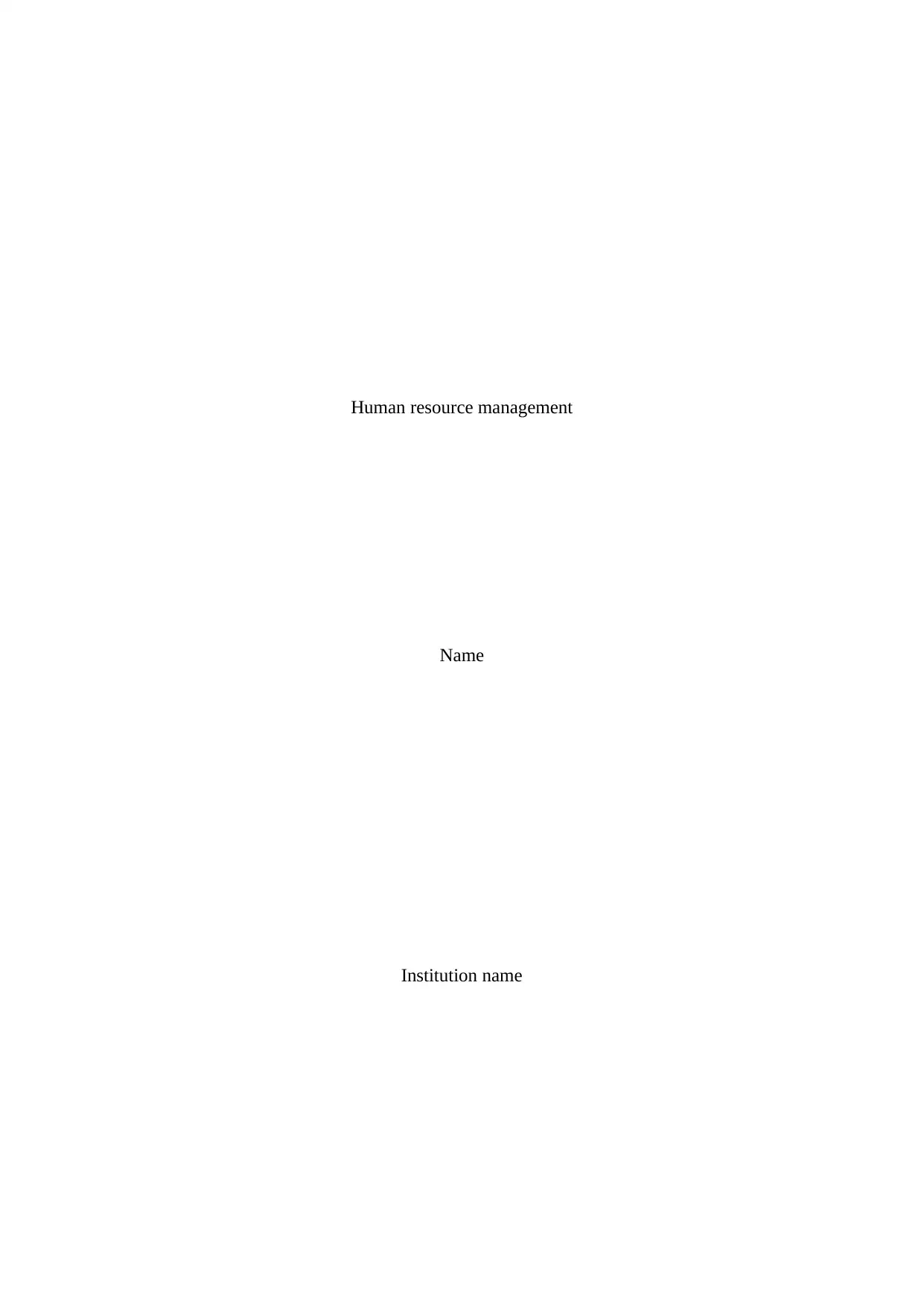
Human resource management
Name
Institution name
Name
Institution name
Paraphrase This Document
Need a fresh take? Get an instant paraphrase of this document with our AI Paraphraser
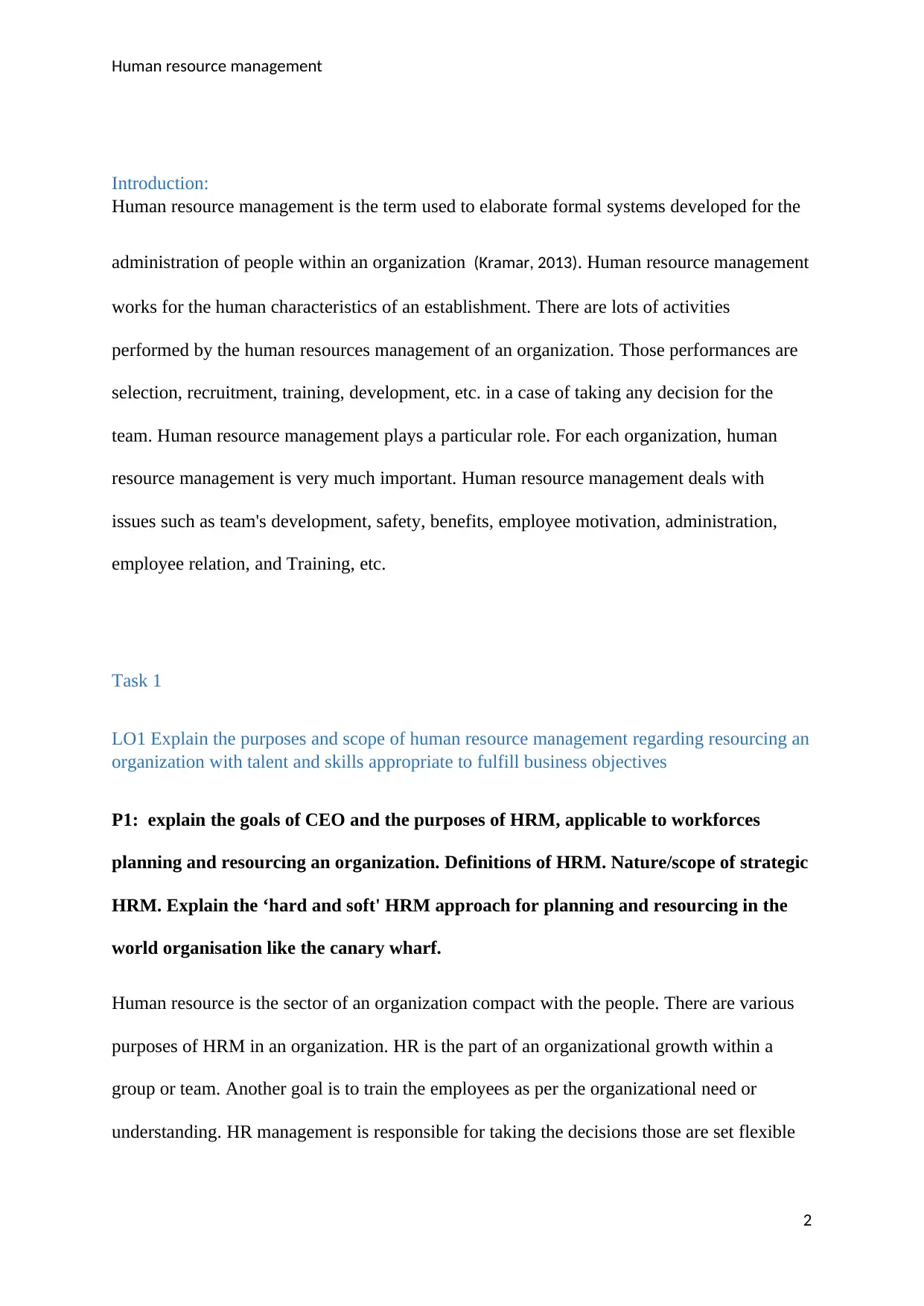
Human resource management
Introduction:
Human resource management is the term used to elaborate formal systems developed for the
administration of people within an organization (Kramar, 2013). Human resource management
works for the human characteristics of an establishment. There are lots of activities
performed by the human resources management of an organization. Those performances are
selection, recruitment, training, development, etc. in a case of taking any decision for the
team. Human resource management plays a particular role. For each organization, human
resource management is very much important. Human resource management deals with
issues such as team's development, safety, benefits, employee motivation, administration,
employee relation, and Training, etc.
Task 1
LO1 Explain the purposes and scope of human resource management regarding resourcing an
organization with talent and skills appropriate to fulfill business objectives
P1: explain the goals of CEO and the purposes of HRM, applicable to workforces
planning and resourcing an organization. Definitions of HRM. Nature/scope of strategic
HRM. Explain the ‘hard and soft' HRM approach for planning and resourcing in the
world organisation like the canary wharf.
Human resource is the sector of an organization compact with the people. There are various
purposes of HRM in an organization. HR is the part of an organizational growth within a
group or team. Another goal is to train the employees as per the organizational need or
understanding. HR management is responsible for taking the decisions those are set flexible
2
Introduction:
Human resource management is the term used to elaborate formal systems developed for the
administration of people within an organization (Kramar, 2013). Human resource management
works for the human characteristics of an establishment. There are lots of activities
performed by the human resources management of an organization. Those performances are
selection, recruitment, training, development, etc. in a case of taking any decision for the
team. Human resource management plays a particular role. For each organization, human
resource management is very much important. Human resource management deals with
issues such as team's development, safety, benefits, employee motivation, administration,
employee relation, and Training, etc.
Task 1
LO1 Explain the purposes and scope of human resource management regarding resourcing an
organization with talent and skills appropriate to fulfill business objectives
P1: explain the goals of CEO and the purposes of HRM, applicable to workforces
planning and resourcing an organization. Definitions of HRM. Nature/scope of strategic
HRM. Explain the ‘hard and soft' HRM approach for planning and resourcing in the
world organisation like the canary wharf.
Human resource is the sector of an organization compact with the people. There are various
purposes of HRM in an organization. HR is the part of an organizational growth within a
group or team. Another goal is to train the employees as per the organizational need or
understanding. HR management is responsible for taking the decisions those are set flexible
2
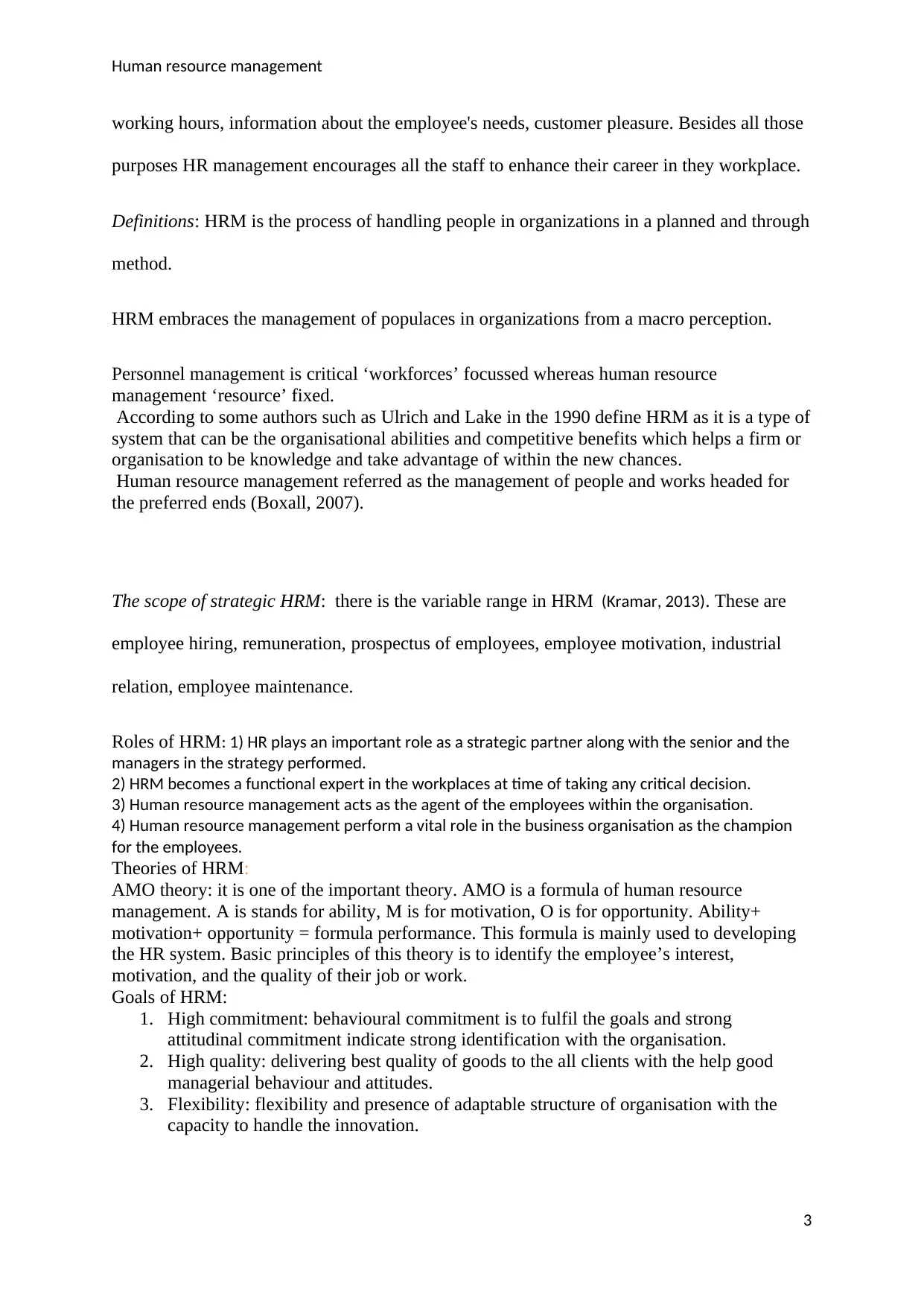
Human resource management
working hours, information about the employee's needs, customer pleasure. Besides all those
purposes HR management encourages all the staff to enhance their career in they workplace.
Definitions: HRM is the process of handling people in organizations in a planned and through
method.
HRM embraces the management of populaces in organizations from a macro perception.
Personnel management is critical ‘workforces’ focussed whereas human resource
management ‘resource’ fixed.
According to some authors such as Ulrich and Lake in the 1990 define HRM as it is a type of
system that can be the organisational abilities and competitive benefits which helps a firm or
organisation to be knowledge and take advantage of within the new chances.
Human resource management referred as the management of people and works headed for
the preferred ends (Boxall, 2007).
The scope of strategic HRM: there is the variable range in HRM (Kramar, 2013). These are
employee hiring, remuneration, prospectus of employees, employee motivation, industrial
relation, employee maintenance.
Roles of HRM: 1) HR plays an important role as a strategic partner along with the senior and the
managers in the strategy performed.
2) HRM becomes a functional expert in the workplaces at time of taking any critical decision.
3) Human resource management acts as the agent of the employees within the organisation.
4) Human resource management perform a vital role in the business organisation as the champion
for the employees.
Theories of HRM:
AMO theory: it is one of the important theory. AMO is a formula of human resource
management. A is stands for ability, M is for motivation, O is for opportunity. Ability+
motivation+ opportunity = formula performance. This formula is mainly used to developing
the HR system. Basic principles of this theory is to identify the employee’s interest,
motivation, and the quality of their job or work.
Goals of HRM:
1. High commitment: behavioural commitment is to fulfil the goals and strong
attitudinal commitment indicate strong identification with the organisation.
2. High quality: delivering best quality of goods to the all clients with the help good
managerial behaviour and attitudes.
3. Flexibility: flexibility and presence of adaptable structure of organisation with the
capacity to handle the innovation.
3
working hours, information about the employee's needs, customer pleasure. Besides all those
purposes HR management encourages all the staff to enhance their career in they workplace.
Definitions: HRM is the process of handling people in organizations in a planned and through
method.
HRM embraces the management of populaces in organizations from a macro perception.
Personnel management is critical ‘workforces’ focussed whereas human resource
management ‘resource’ fixed.
According to some authors such as Ulrich and Lake in the 1990 define HRM as it is a type of
system that can be the organisational abilities and competitive benefits which helps a firm or
organisation to be knowledge and take advantage of within the new chances.
Human resource management referred as the management of people and works headed for
the preferred ends (Boxall, 2007).
The scope of strategic HRM: there is the variable range in HRM (Kramar, 2013). These are
employee hiring, remuneration, prospectus of employees, employee motivation, industrial
relation, employee maintenance.
Roles of HRM: 1) HR plays an important role as a strategic partner along with the senior and the
managers in the strategy performed.
2) HRM becomes a functional expert in the workplaces at time of taking any critical decision.
3) Human resource management acts as the agent of the employees within the organisation.
4) Human resource management perform a vital role in the business organisation as the champion
for the employees.
Theories of HRM:
AMO theory: it is one of the important theory. AMO is a formula of human resource
management. A is stands for ability, M is for motivation, O is for opportunity. Ability+
motivation+ opportunity = formula performance. This formula is mainly used to developing
the HR system. Basic principles of this theory is to identify the employee’s interest,
motivation, and the quality of their job or work.
Goals of HRM:
1. High commitment: behavioural commitment is to fulfil the goals and strong
attitudinal commitment indicate strong identification with the organisation.
2. High quality: delivering best quality of goods to the all clients with the help good
managerial behaviour and attitudes.
3. Flexibility: flexibility and presence of adaptable structure of organisation with the
capacity to handle the innovation.
3
⊘ This is a preview!⊘
Do you want full access?
Subscribe today to unlock all pages.

Trusted by 1+ million students worldwide
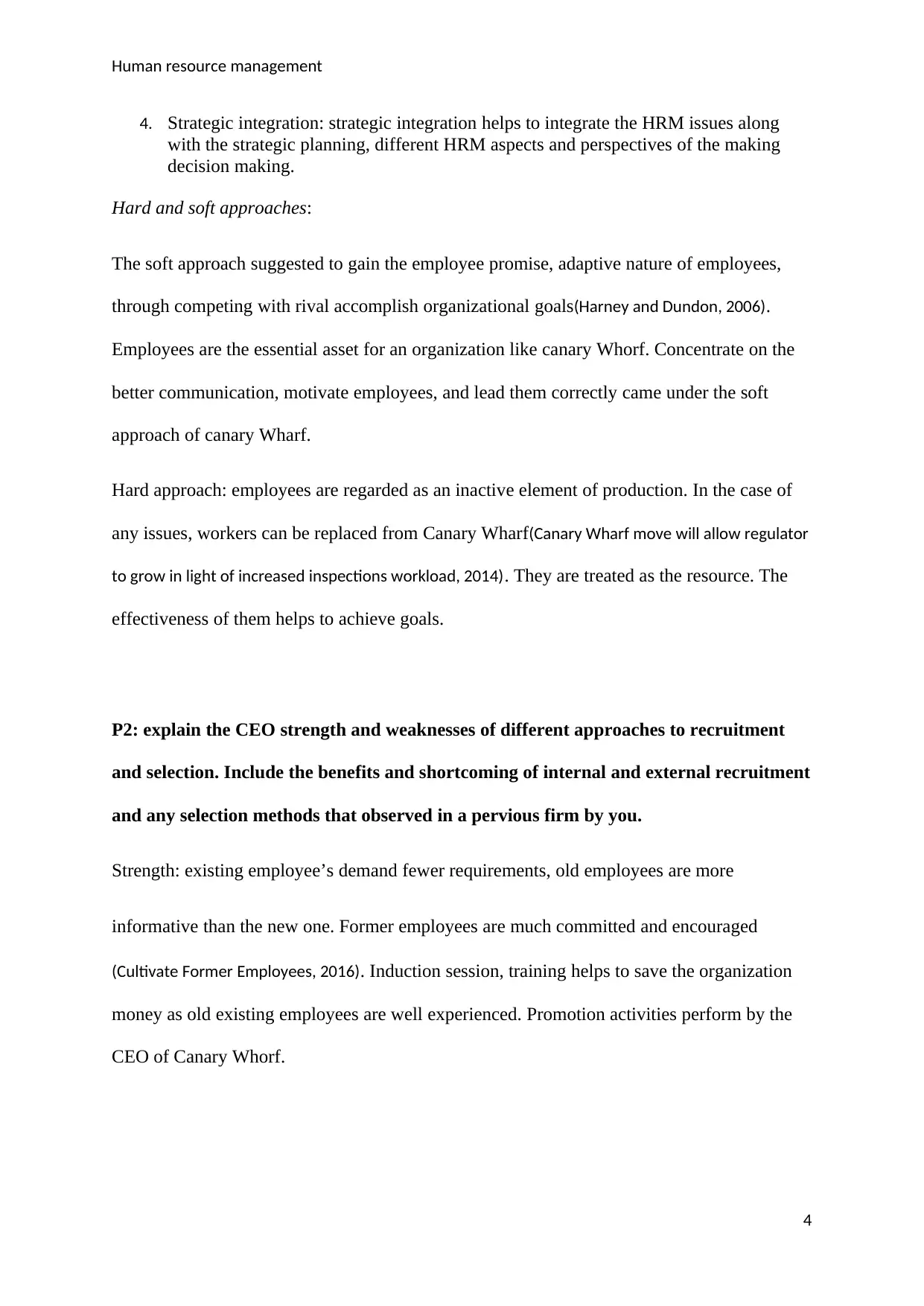
Human resource management
4. Strategic integration: strategic integration helps to integrate the HRM issues along
with the strategic planning, different HRM aspects and perspectives of the making
decision making.
Hard and soft approaches:
The soft approach suggested to gain the employee promise, adaptive nature of employees,
through competing with rival accomplish organizational goals(Harney and Dundon, 2006).
Employees are the essential asset for an organization like canary Whorf. Concentrate on the
better communication, motivate employees, and lead them correctly came under the soft
approach of canary Wharf.
Hard approach: employees are regarded as an inactive element of production. In the case of
any issues, workers can be replaced from Canary Wharf(Canary Wharf move will allow regulator
to grow in light of increased inspections workload, 2014). They are treated as the resource. The
effectiveness of them helps to achieve goals.
P2: explain the CEO strength and weaknesses of different approaches to recruitment
and selection. Include the benefits and shortcoming of internal and external recruitment
and any selection methods that observed in a pervious firm by you.
Strength: existing employee’s demand fewer requirements, old employees are more
informative than the new one. Former employees are much committed and encouraged
(Cultivate Former Employees, 2016). Induction session, training helps to save the organization
money as old existing employees are well experienced. Promotion activities perform by the
CEO of Canary Whorf.
4
4. Strategic integration: strategic integration helps to integrate the HRM issues along
with the strategic planning, different HRM aspects and perspectives of the making
decision making.
Hard and soft approaches:
The soft approach suggested to gain the employee promise, adaptive nature of employees,
through competing with rival accomplish organizational goals(Harney and Dundon, 2006).
Employees are the essential asset for an organization like canary Whorf. Concentrate on the
better communication, motivate employees, and lead them correctly came under the soft
approach of canary Wharf.
Hard approach: employees are regarded as an inactive element of production. In the case of
any issues, workers can be replaced from Canary Wharf(Canary Wharf move will allow regulator
to grow in light of increased inspections workload, 2014). They are treated as the resource. The
effectiveness of them helps to achieve goals.
P2: explain the CEO strength and weaknesses of different approaches to recruitment
and selection. Include the benefits and shortcoming of internal and external recruitment
and any selection methods that observed in a pervious firm by you.
Strength: existing employee’s demand fewer requirements, old employees are more
informative than the new one. Former employees are much committed and encouraged
(Cultivate Former Employees, 2016). Induction session, training helps to save the organization
money as old existing employees are well experienced. Promotion activities perform by the
CEO of Canary Whorf.
4
Paraphrase This Document
Need a fresh take? Get an instant paraphrase of this document with our AI Paraphraser
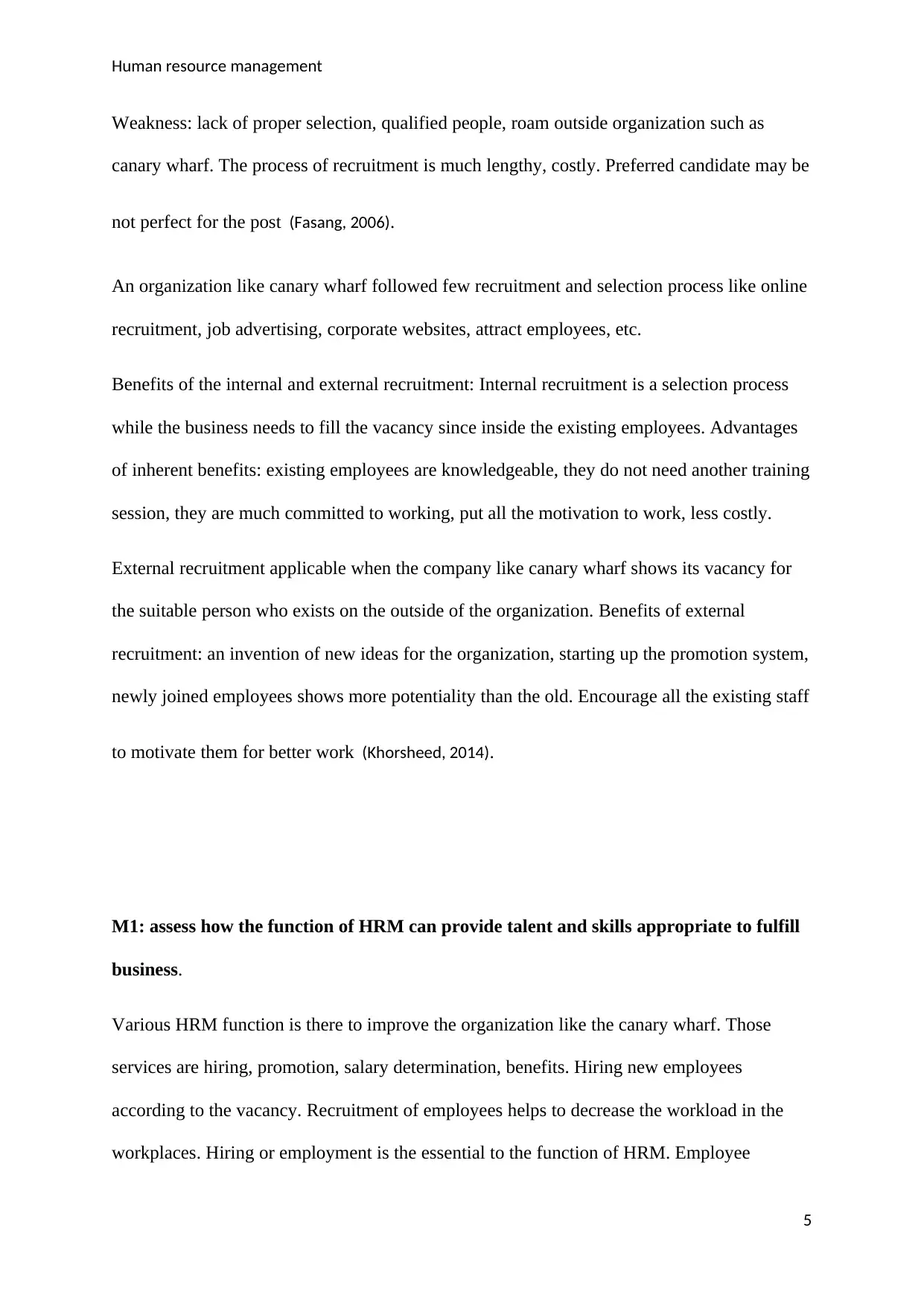
Human resource management
Weakness: lack of proper selection, qualified people, roam outside organization such as
canary wharf. The process of recruitment is much lengthy, costly. Preferred candidate may be
not perfect for the post (Fasang, 2006).
An organization like canary wharf followed few recruitment and selection process like online
recruitment, job advertising, corporate websites, attract employees, etc.
Benefits of the internal and external recruitment: Internal recruitment is a selection process
while the business needs to fill the vacancy since inside the existing employees. Advantages
of inherent benefits: existing employees are knowledgeable, they do not need another training
session, they are much committed to working, put all the motivation to work, less costly.
External recruitment applicable when the company like canary wharf shows its vacancy for
the suitable person who exists on the outside of the organization. Benefits of external
recruitment: an invention of new ideas for the organization, starting up the promotion system,
newly joined employees shows more potentiality than the old. Encourage all the existing staff
to motivate them for better work (Khorsheed, 2014).
M1: assess how the function of HRM can provide talent and skills appropriate to fulfill
business.
Various HRM function is there to improve the organization like the canary wharf. Those
services are hiring, promotion, salary determination, benefits. Hiring new employees
according to the vacancy. Recruitment of employees helps to decrease the workload in the
workplaces. Hiring or employment is the essential to the function of HRM. Employee
5
Weakness: lack of proper selection, qualified people, roam outside organization such as
canary wharf. The process of recruitment is much lengthy, costly. Preferred candidate may be
not perfect for the post (Fasang, 2006).
An organization like canary wharf followed few recruitment and selection process like online
recruitment, job advertising, corporate websites, attract employees, etc.
Benefits of the internal and external recruitment: Internal recruitment is a selection process
while the business needs to fill the vacancy since inside the existing employees. Advantages
of inherent benefits: existing employees are knowledgeable, they do not need another training
session, they are much committed to working, put all the motivation to work, less costly.
External recruitment applicable when the company like canary wharf shows its vacancy for
the suitable person who exists on the outside of the organization. Benefits of external
recruitment: an invention of new ideas for the organization, starting up the promotion system,
newly joined employees shows more potentiality than the old. Encourage all the existing staff
to motivate them for better work (Khorsheed, 2014).
M1: assess how the function of HRM can provide talent and skills appropriate to fulfill
business.
Various HRM function is there to improve the organization like the canary wharf. Those
services are hiring, promotion, salary determination, benefits. Hiring new employees
according to the vacancy. Recruitment of employees helps to decrease the workload in the
workplaces. Hiring or employment is the essential to the function of HRM. Employee
5
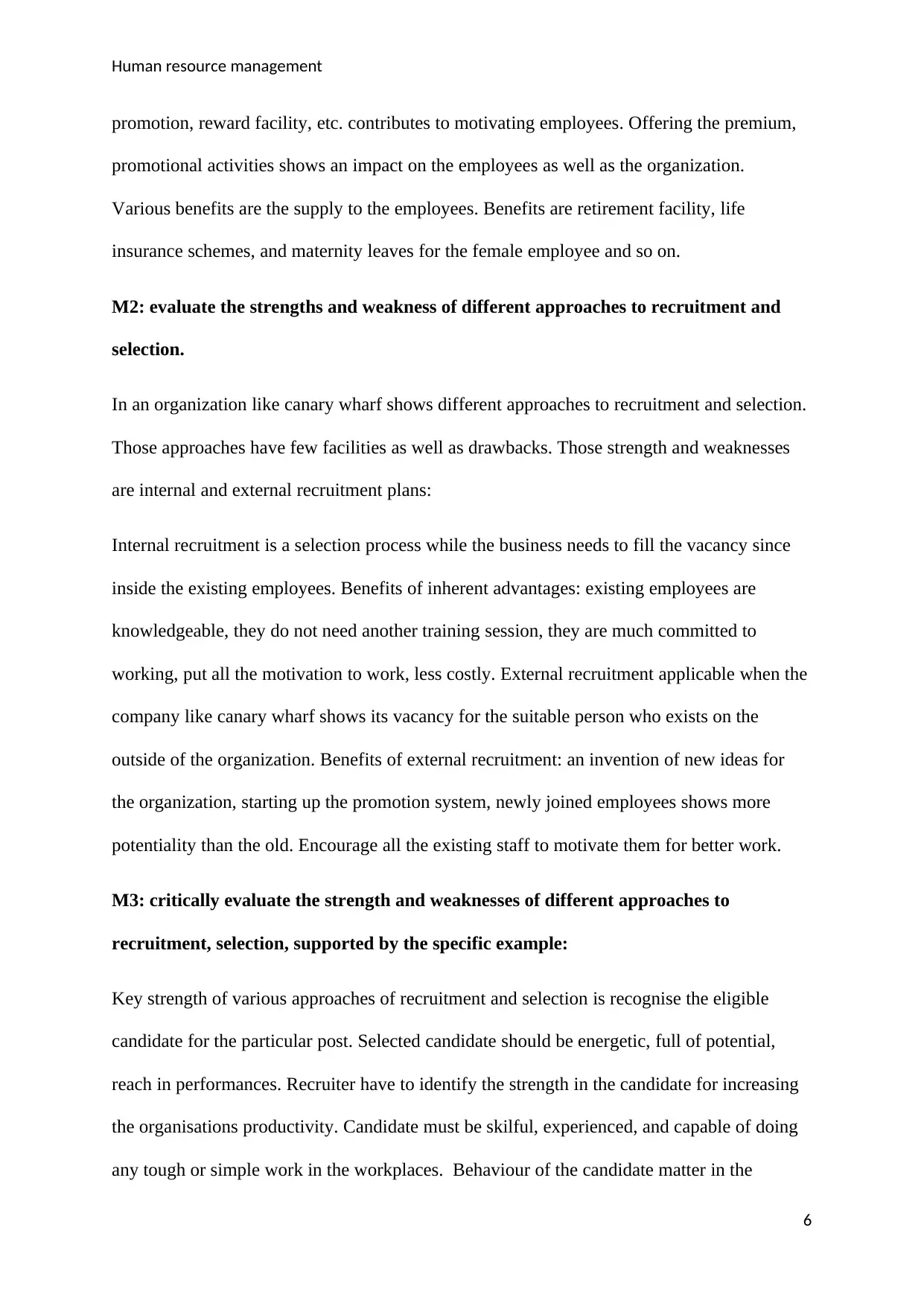
Human resource management
promotion, reward facility, etc. contributes to motivating employees. Offering the premium,
promotional activities shows an impact on the employees as well as the organization.
Various benefits are the supply to the employees. Benefits are retirement facility, life
insurance schemes, and maternity leaves for the female employee and so on.
M2: evaluate the strengths and weakness of different approaches to recruitment and
selection.
In an organization like canary wharf shows different approaches to recruitment and selection.
Those approaches have few facilities as well as drawbacks. Those strength and weaknesses
are internal and external recruitment plans:
Internal recruitment is a selection process while the business needs to fill the vacancy since
inside the existing employees. Benefits of inherent advantages: existing employees are
knowledgeable, they do not need another training session, they are much committed to
working, put all the motivation to work, less costly. External recruitment applicable when the
company like canary wharf shows its vacancy for the suitable person who exists on the
outside of the organization. Benefits of external recruitment: an invention of new ideas for
the organization, starting up the promotion system, newly joined employees shows more
potentiality than the old. Encourage all the existing staff to motivate them for better work.
M3: critically evaluate the strength and weaknesses of different approaches to
recruitment, selection, supported by the specific example:
Key strength of various approaches of recruitment and selection is recognise the eligible
candidate for the particular post. Selected candidate should be energetic, full of potential,
reach in performances. Recruiter have to identify the strength in the candidate for increasing
the organisations productivity. Candidate must be skilful, experienced, and capable of doing
any tough or simple work in the workplaces. Behaviour of the candidate matter in the
6
promotion, reward facility, etc. contributes to motivating employees. Offering the premium,
promotional activities shows an impact on the employees as well as the organization.
Various benefits are the supply to the employees. Benefits are retirement facility, life
insurance schemes, and maternity leaves for the female employee and so on.
M2: evaluate the strengths and weakness of different approaches to recruitment and
selection.
In an organization like canary wharf shows different approaches to recruitment and selection.
Those approaches have few facilities as well as drawbacks. Those strength and weaknesses
are internal and external recruitment plans:
Internal recruitment is a selection process while the business needs to fill the vacancy since
inside the existing employees. Benefits of inherent advantages: existing employees are
knowledgeable, they do not need another training session, they are much committed to
working, put all the motivation to work, less costly. External recruitment applicable when the
company like canary wharf shows its vacancy for the suitable person who exists on the
outside of the organization. Benefits of external recruitment: an invention of new ideas for
the organization, starting up the promotion system, newly joined employees shows more
potentiality than the old. Encourage all the existing staff to motivate them for better work.
M3: critically evaluate the strength and weaknesses of different approaches to
recruitment, selection, supported by the specific example:
Key strength of various approaches of recruitment and selection is recognise the eligible
candidate for the particular post. Selected candidate should be energetic, full of potential,
reach in performances. Recruiter have to identify the strength in the candidate for increasing
the organisations productivity. Candidate must be skilful, experienced, and capable of doing
any tough or simple work in the workplaces. Behaviour of the candidate matter in the
6
⊘ This is a preview!⊘
Do you want full access?
Subscribe today to unlock all pages.

Trusted by 1+ million students worldwide
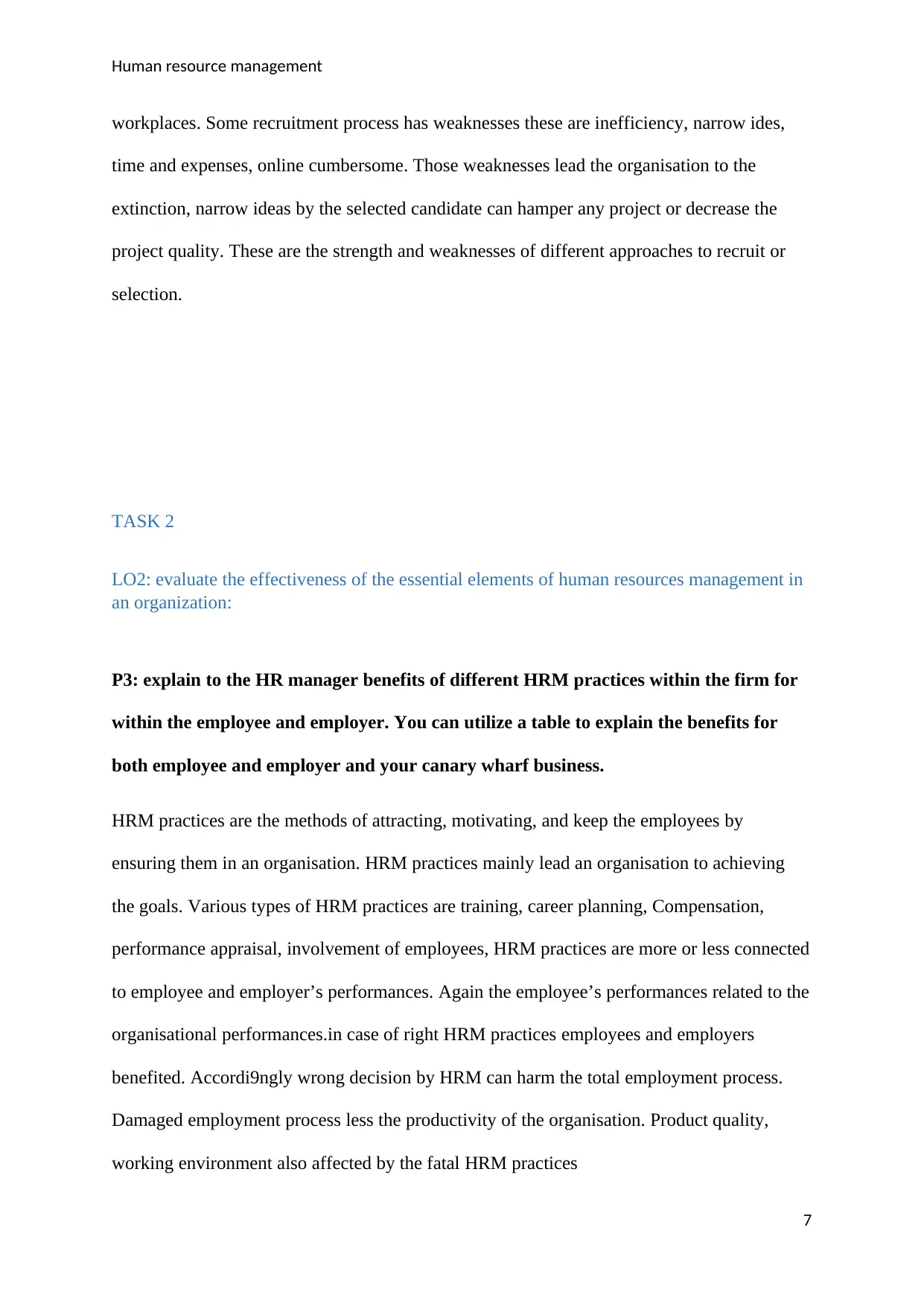
Human resource management
workplaces. Some recruitment process has weaknesses these are inefficiency, narrow ides,
time and expenses, online cumbersome. Those weaknesses lead the organisation to the
extinction, narrow ideas by the selected candidate can hamper any project or decrease the
project quality. These are the strength and weaknesses of different approaches to recruit or
selection.
TASK 2
LO2: evaluate the effectiveness of the essential elements of human resources management in
an organization:
P3: explain to the HR manager benefits of different HRM practices within the firm for
within the employee and employer. You can utilize a table to explain the benefits for
both employee and employer and your canary wharf business.
HRM practices are the methods of attracting, motivating, and keep the employees by
ensuring them in an organisation. HRM practices mainly lead an organisation to achieving
the goals. Various types of HRM practices are training, career planning, Compensation,
performance appraisal, involvement of employees, HRM practices are more or less connected
to employee and employer’s performances. Again the employee’s performances related to the
organisational performances.in case of right HRM practices employees and employers
benefited. Accordi9ngly wrong decision by HRM can harm the total employment process.
Damaged employment process less the productivity of the organisation. Product quality,
working environment also affected by the fatal HRM practices
7
workplaces. Some recruitment process has weaknesses these are inefficiency, narrow ides,
time and expenses, online cumbersome. Those weaknesses lead the organisation to the
extinction, narrow ideas by the selected candidate can hamper any project or decrease the
project quality. These are the strength and weaknesses of different approaches to recruit or
selection.
TASK 2
LO2: evaluate the effectiveness of the essential elements of human resources management in
an organization:
P3: explain to the HR manager benefits of different HRM practices within the firm for
within the employee and employer. You can utilize a table to explain the benefits for
both employee and employer and your canary wharf business.
HRM practices are the methods of attracting, motivating, and keep the employees by
ensuring them in an organisation. HRM practices mainly lead an organisation to achieving
the goals. Various types of HRM practices are training, career planning, Compensation,
performance appraisal, involvement of employees, HRM practices are more or less connected
to employee and employer’s performances. Again the employee’s performances related to the
organisational performances.in case of right HRM practices employees and employers
benefited. Accordi9ngly wrong decision by HRM can harm the total employment process.
Damaged employment process less the productivity of the organisation. Product quality,
working environment also affected by the fatal HRM practices
7
Paraphrase This Document
Need a fresh take? Get an instant paraphrase of this document with our AI Paraphraser
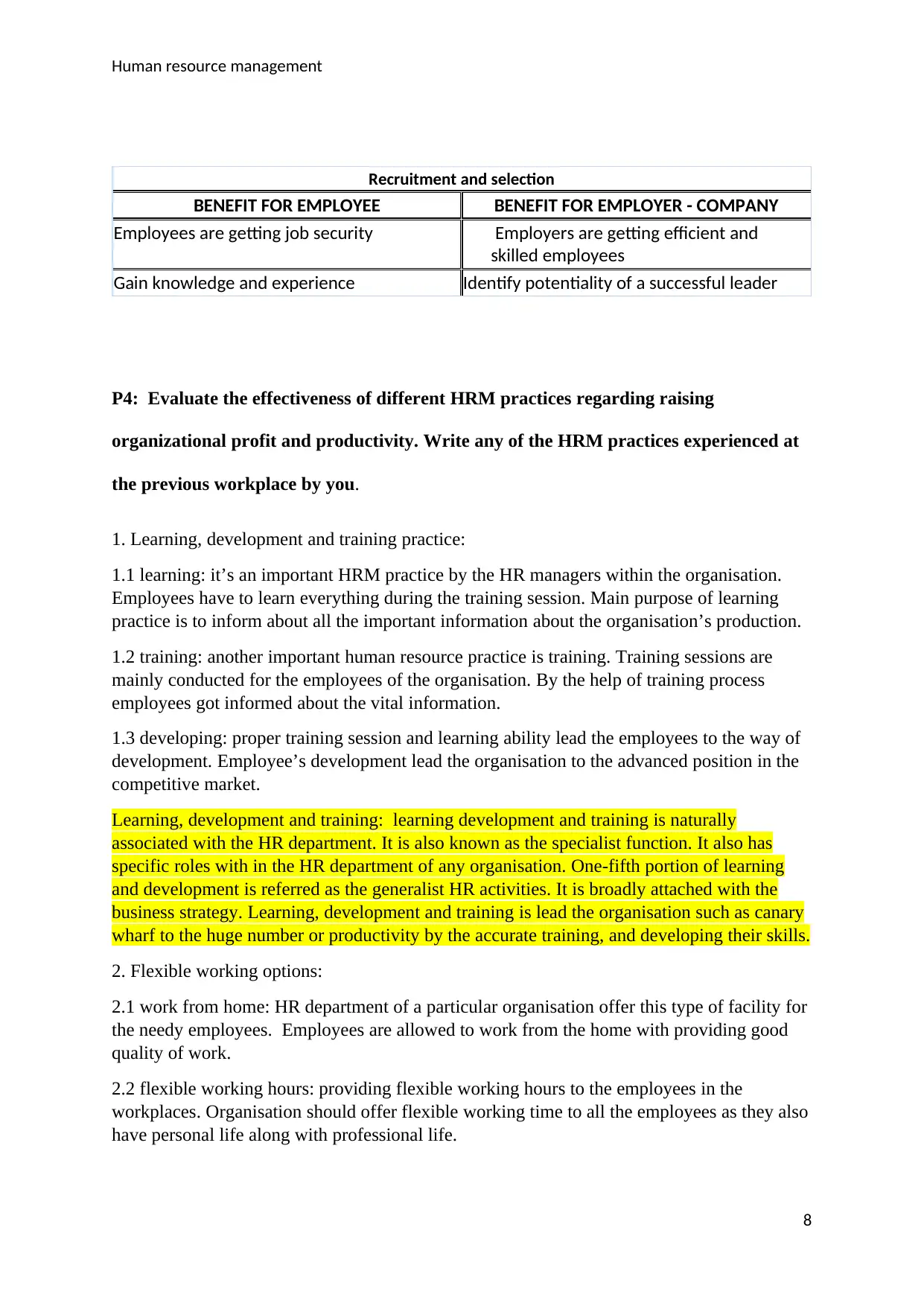
Human resource management
Recruitment and selection
BENEFIT FOR EMPLOYEE BENEFIT FOR EMPLOYER - COMPANY
Employees are getting job security Employers are getting efficient and
skilled employees
Gain knowledge and experience Identify potentiality of a successful leader
P4: Evaluate the effectiveness of different HRM practices regarding raising
organizational profit and productivity. Write any of the HRM practices experienced at
the previous workplace by you.
1. Learning, development and training practice:
1.1 learning: it’s an important HRM practice by the HR managers within the organisation.
Employees have to learn everything during the training session. Main purpose of learning
practice is to inform about all the important information about the organisation’s production.
1.2 training: another important human resource practice is training. Training sessions are
mainly conducted for the employees of the organisation. By the help of training process
employees got informed about the vital information.
1.3 developing: proper training session and learning ability lead the employees to the way of
development. Employee’s development lead the organisation to the advanced position in the
competitive market.
Learning, development and training: learning development and training is naturally
associated with the HR department. It is also known as the specialist function. It also has
specific roles with in the HR department of any organisation. One-fifth portion of learning
and development is referred as the generalist HR activities. It is broadly attached with the
business strategy. Learning, development and training is lead the organisation such as canary
wharf to the huge number or productivity by the accurate training, and developing their skills.
2. Flexible working options:
2.1 work from home: HR department of a particular organisation offer this type of facility for
the needy employees. Employees are allowed to work from the home with providing good
quality of work.
2.2 flexible working hours: providing flexible working hours to the employees in the
workplaces. Organisation should offer flexible working time to all the employees as they also
have personal life along with professional life.
8
Recruitment and selection
BENEFIT FOR EMPLOYEE BENEFIT FOR EMPLOYER - COMPANY
Employees are getting job security Employers are getting efficient and
skilled employees
Gain knowledge and experience Identify potentiality of a successful leader
P4: Evaluate the effectiveness of different HRM practices regarding raising
organizational profit and productivity. Write any of the HRM practices experienced at
the previous workplace by you.
1. Learning, development and training practice:
1.1 learning: it’s an important HRM practice by the HR managers within the organisation.
Employees have to learn everything during the training session. Main purpose of learning
practice is to inform about all the important information about the organisation’s production.
1.2 training: another important human resource practice is training. Training sessions are
mainly conducted for the employees of the organisation. By the help of training process
employees got informed about the vital information.
1.3 developing: proper training session and learning ability lead the employees to the way of
development. Employee’s development lead the organisation to the advanced position in the
competitive market.
Learning, development and training: learning development and training is naturally
associated with the HR department. It is also known as the specialist function. It also has
specific roles with in the HR department of any organisation. One-fifth portion of learning
and development is referred as the generalist HR activities. It is broadly attached with the
business strategy. Learning, development and training is lead the organisation such as canary
wharf to the huge number or productivity by the accurate training, and developing their skills.
2. Flexible working options:
2.1 work from home: HR department of a particular organisation offer this type of facility for
the needy employees. Employees are allowed to work from the home with providing good
quality of work.
2.2 flexible working hours: providing flexible working hours to the employees in the
workplaces. Organisation should offer flexible working time to all the employees as they also
have personal life along with professional life.
8
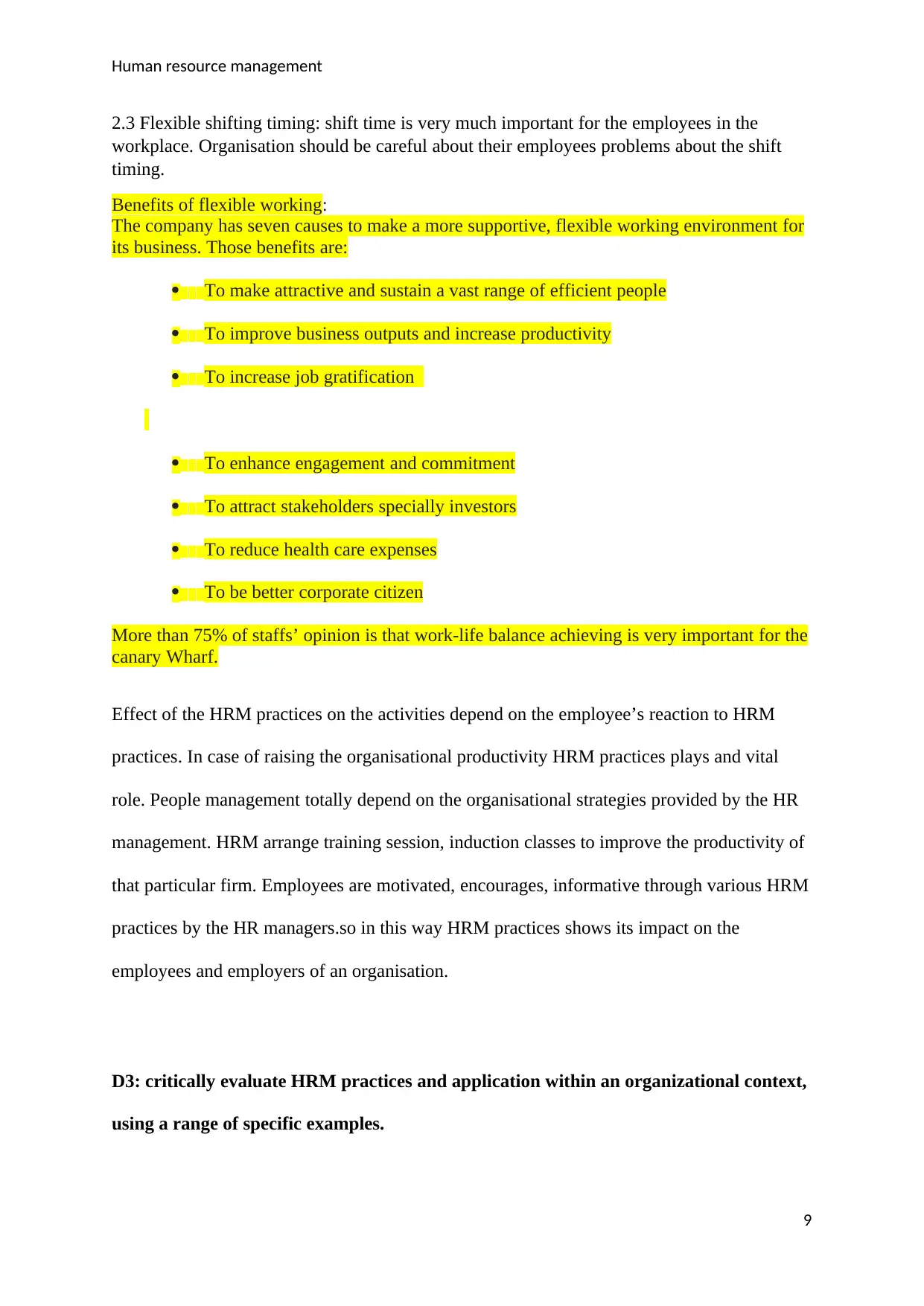
Human resource management
2.3 Flexible shifting timing: shift time is very much important for the employees in the
workplace. Organisation should be careful about their employees problems about the shift
timing.
Benefits of flexible working:
The company has seven causes to make a more supportive, flexible working environment for
its business. Those benefits are:
To make attractive and sustain a vast range of efficient people
To improve business outputs and increase productivity
To increase job gratification
To enhance engagement and commitment
To attract stakeholders specially investors
To reduce health care expenses
To be better corporate citizen
More than 75% of staffs’ opinion is that work-life balance achieving is very important for the
canary Wharf.
Effect of the HRM practices on the activities depend on the employee’s reaction to HRM
practices. In case of raising the organisational productivity HRM practices plays and vital
role. People management totally depend on the organisational strategies provided by the HR
management. HRM arrange training session, induction classes to improve the productivity of
that particular firm. Employees are motivated, encourages, informative through various HRM
practices by the HR managers.so in this way HRM practices shows its impact on the
employees and employers of an organisation.
D3: critically evaluate HRM practices and application within an organizational context,
using a range of specific examples.
9
2.3 Flexible shifting timing: shift time is very much important for the employees in the
workplace. Organisation should be careful about their employees problems about the shift
timing.
Benefits of flexible working:
The company has seven causes to make a more supportive, flexible working environment for
its business. Those benefits are:
To make attractive and sustain a vast range of efficient people
To improve business outputs and increase productivity
To increase job gratification
To enhance engagement and commitment
To attract stakeholders specially investors
To reduce health care expenses
To be better corporate citizen
More than 75% of staffs’ opinion is that work-life balance achieving is very important for the
canary Wharf.
Effect of the HRM practices on the activities depend on the employee’s reaction to HRM
practices. In case of raising the organisational productivity HRM practices plays and vital
role. People management totally depend on the organisational strategies provided by the HR
management. HRM arrange training session, induction classes to improve the productivity of
that particular firm. Employees are motivated, encourages, informative through various HRM
practices by the HR managers.so in this way HRM practices shows its impact on the
employees and employers of an organisation.
D3: critically evaluate HRM practices and application within an organizational context,
using a range of specific examples.
9
⊘ This is a preview!⊘
Do you want full access?
Subscribe today to unlock all pages.

Trusted by 1+ million students worldwide
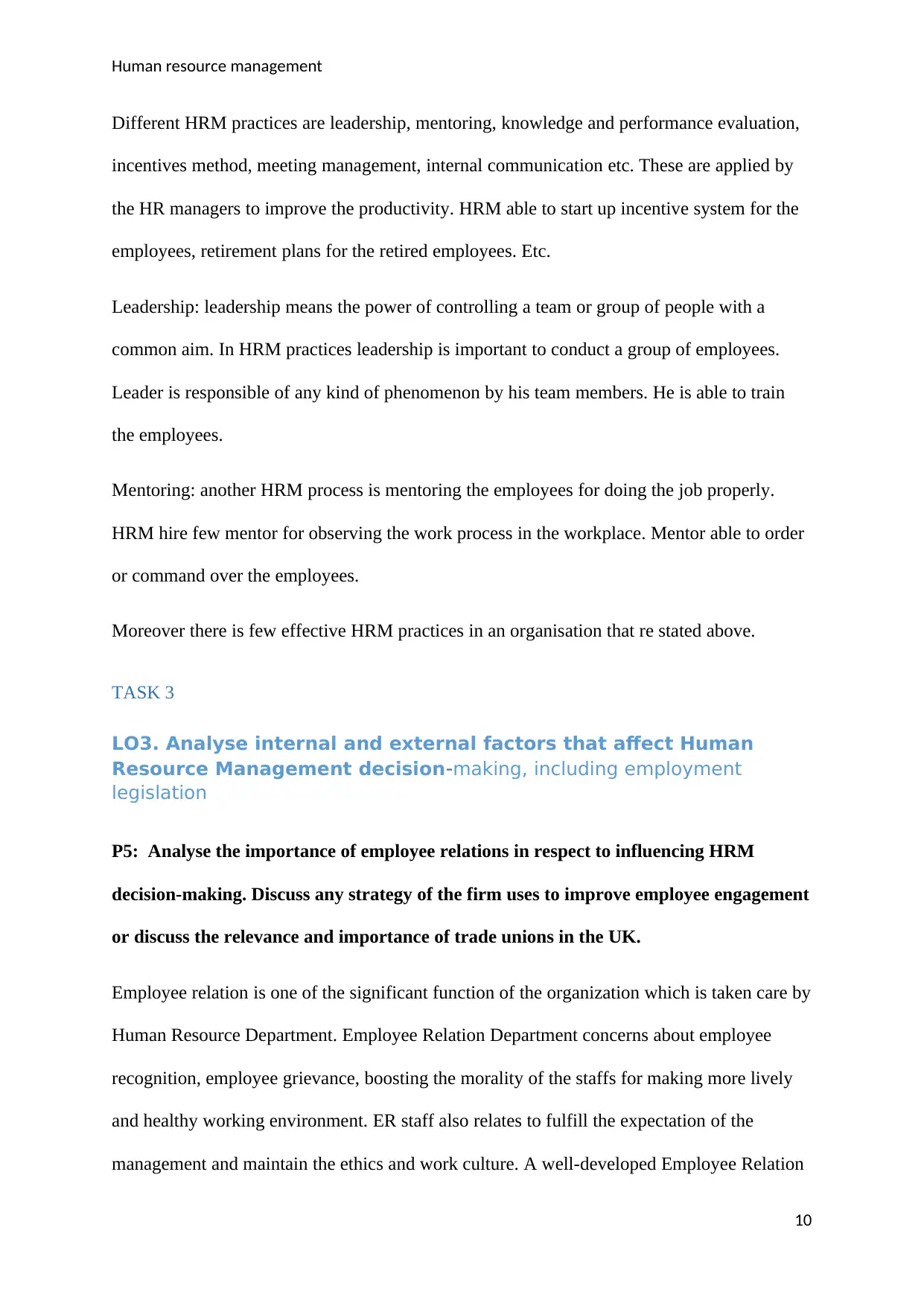
Human resource management
Different HRM practices are leadership, mentoring, knowledge and performance evaluation,
incentives method, meeting management, internal communication etc. These are applied by
the HR managers to improve the productivity. HRM able to start up incentive system for the
employees, retirement plans for the retired employees. Etc.
Leadership: leadership means the power of controlling a team or group of people with a
common aim. In HRM practices leadership is important to conduct a group of employees.
Leader is responsible of any kind of phenomenon by his team members. He is able to train
the employees.
Mentoring: another HRM process is mentoring the employees for doing the job properly.
HRM hire few mentor for observing the work process in the workplace. Mentor able to order
or command over the employees.
Moreover there is few effective HRM practices in an organisation that re stated above.
TASK 3
LO3. Analyse internal and external factors that affect Human
Resource Management decision-making, including employment
legislation
P5: Analyse the importance of employee relations in respect to influencing HRM
decision-making. Discuss any strategy of the firm uses to improve employee engagement
or discuss the relevance and importance of trade unions in the UK.
Employee relation is one of the significant function of the organization which is taken care by
Human Resource Department. Employee Relation Department concerns about employee
recognition, employee grievance, boosting the morality of the staffs for making more lively
and healthy working environment. ER staff also relates to fulfill the expectation of the
management and maintain the ethics and work culture. A well-developed Employee Relation
10
Different HRM practices are leadership, mentoring, knowledge and performance evaluation,
incentives method, meeting management, internal communication etc. These are applied by
the HR managers to improve the productivity. HRM able to start up incentive system for the
employees, retirement plans for the retired employees. Etc.
Leadership: leadership means the power of controlling a team or group of people with a
common aim. In HRM practices leadership is important to conduct a group of employees.
Leader is responsible of any kind of phenomenon by his team members. He is able to train
the employees.
Mentoring: another HRM process is mentoring the employees for doing the job properly.
HRM hire few mentor for observing the work process in the workplace. Mentor able to order
or command over the employees.
Moreover there is few effective HRM practices in an organisation that re stated above.
TASK 3
LO3. Analyse internal and external factors that affect Human
Resource Management decision-making, including employment
legislation
P5: Analyse the importance of employee relations in respect to influencing HRM
decision-making. Discuss any strategy of the firm uses to improve employee engagement
or discuss the relevance and importance of trade unions in the UK.
Employee relation is one of the significant function of the organization which is taken care by
Human Resource Department. Employee Relation Department concerns about employee
recognition, employee grievance, boosting the morality of the staffs for making more lively
and healthy working environment. ER staff also relates to fulfill the expectation of the
management and maintain the ethics and work culture. A well-developed Employee Relation
10
Paraphrase This Document
Need a fresh take? Get an instant paraphrase of this document with our AI Paraphraser
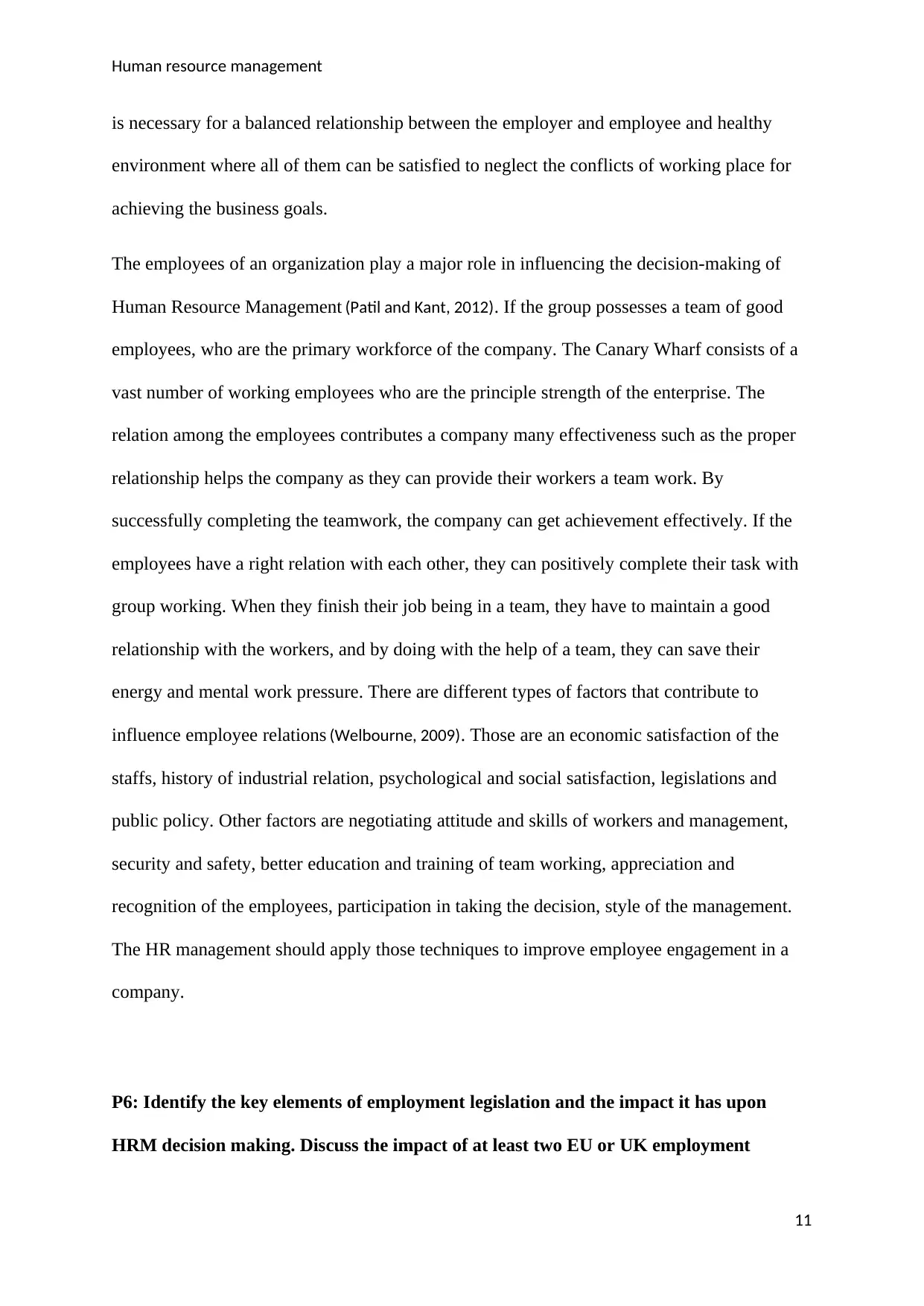
Human resource management
is necessary for a balanced relationship between the employer and employee and healthy
environment where all of them can be satisfied to neglect the conflicts of working place for
achieving the business goals.
The employees of an organization play a major role in influencing the decision-making of
Human Resource Management (Patil and Kant, 2012). If the group possesses a team of good
employees, who are the primary workforce of the company. The Canary Wharf consists of a
vast number of working employees who are the principle strength of the enterprise. The
relation among the employees contributes a company many effectiveness such as the proper
relationship helps the company as they can provide their workers a team work. By
successfully completing the teamwork, the company can get achievement effectively. If the
employees have a right relation with each other, they can positively complete their task with
group working. When they finish their job being in a team, they have to maintain a good
relationship with the workers, and by doing with the help of a team, they can save their
energy and mental work pressure. There are different types of factors that contribute to
influence employee relations (Welbourne, 2009). Those are an economic satisfaction of the
staffs, history of industrial relation, psychological and social satisfaction, legislations and
public policy. Other factors are negotiating attitude and skills of workers and management,
security and safety, better education and training of team working, appreciation and
recognition of the employees, participation in taking the decision, style of the management.
The HR management should apply those techniques to improve employee engagement in a
company.
P6: Identify the key elements of employment legislation and the impact it has upon
HRM decision making. Discuss the impact of at least two EU or UK employment
11
is necessary for a balanced relationship between the employer and employee and healthy
environment where all of them can be satisfied to neglect the conflicts of working place for
achieving the business goals.
The employees of an organization play a major role in influencing the decision-making of
Human Resource Management (Patil and Kant, 2012). If the group possesses a team of good
employees, who are the primary workforce of the company. The Canary Wharf consists of a
vast number of working employees who are the principle strength of the enterprise. The
relation among the employees contributes a company many effectiveness such as the proper
relationship helps the company as they can provide their workers a team work. By
successfully completing the teamwork, the company can get achievement effectively. If the
employees have a right relation with each other, they can positively complete their task with
group working. When they finish their job being in a team, they have to maintain a good
relationship with the workers, and by doing with the help of a team, they can save their
energy and mental work pressure. There are different types of factors that contribute to
influence employee relations (Welbourne, 2009). Those are an economic satisfaction of the
staffs, history of industrial relation, psychological and social satisfaction, legislations and
public policy. Other factors are negotiating attitude and skills of workers and management,
security and safety, better education and training of team working, appreciation and
recognition of the employees, participation in taking the decision, style of the management.
The HR management should apply those techniques to improve employee engagement in a
company.
P6: Identify the key elements of employment legislation and the impact it has upon
HRM decision making. Discuss the impact of at least two EU or UK employment
11
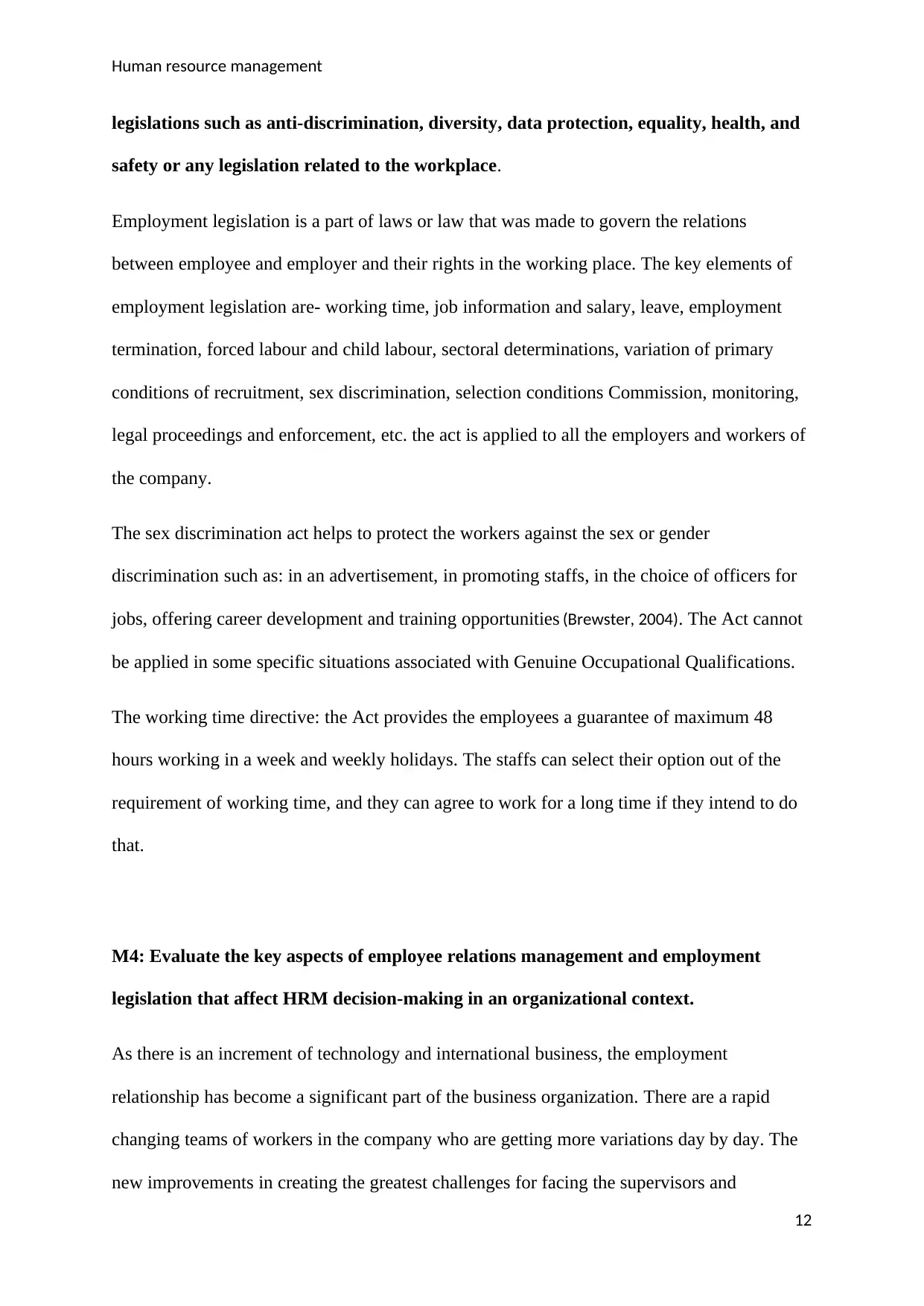
Human resource management
legislations such as anti-discrimination, diversity, data protection, equality, health, and
safety or any legislation related to the workplace.
Employment legislation is a part of laws or law that was made to govern the relations
between employee and employer and their rights in the working place. The key elements of
employment legislation are- working time, job information and salary, leave, employment
termination, forced labour and child labour, sectoral determinations, variation of primary
conditions of recruitment, sex discrimination, selection conditions Commission, monitoring,
legal proceedings and enforcement, etc. the act is applied to all the employers and workers of
the company.
The sex discrimination act helps to protect the workers against the sex or gender
discrimination such as: in an advertisement, in promoting staffs, in the choice of officers for
jobs, offering career development and training opportunities (Brewster, 2004). The Act cannot
be applied in some specific situations associated with Genuine Occupational Qualifications.
The working time directive: the Act provides the employees a guarantee of maximum 48
hours working in a week and weekly holidays. The staffs can select their option out of the
requirement of working time, and they can agree to work for a long time if they intend to do
that.
M4: Evaluate the key aspects of employee relations management and employment
legislation that affect HRM decision-making in an organizational context.
As there is an increment of technology and international business, the employment
relationship has become a significant part of the business organization. There are a rapid
changing teams of workers in the company who are getting more variations day by day. The
new improvements in creating the greatest challenges for facing the supervisors and
12
legislations such as anti-discrimination, diversity, data protection, equality, health, and
safety or any legislation related to the workplace.
Employment legislation is a part of laws or law that was made to govern the relations
between employee and employer and their rights in the working place. The key elements of
employment legislation are- working time, job information and salary, leave, employment
termination, forced labour and child labour, sectoral determinations, variation of primary
conditions of recruitment, sex discrimination, selection conditions Commission, monitoring,
legal proceedings and enforcement, etc. the act is applied to all the employers and workers of
the company.
The sex discrimination act helps to protect the workers against the sex or gender
discrimination such as: in an advertisement, in promoting staffs, in the choice of officers for
jobs, offering career development and training opportunities (Brewster, 2004). The Act cannot
be applied in some specific situations associated with Genuine Occupational Qualifications.
The working time directive: the Act provides the employees a guarantee of maximum 48
hours working in a week and weekly holidays. The staffs can select their option out of the
requirement of working time, and they can agree to work for a long time if they intend to do
that.
M4: Evaluate the key aspects of employee relations management and employment
legislation that affect HRM decision-making in an organizational context.
As there is an increment of technology and international business, the employment
relationship has become a significant part of the business organization. There are a rapid
changing teams of workers in the company who are getting more variations day by day. The
new improvements in creating the greatest challenges for facing the supervisors and
12
⊘ This is a preview!⊘
Do you want full access?
Subscribe today to unlock all pages.

Trusted by 1+ million students worldwide
1 out of 17
Related Documents
Your All-in-One AI-Powered Toolkit for Academic Success.
+13062052269
info@desklib.com
Available 24*7 on WhatsApp / Email
![[object Object]](/_next/static/media/star-bottom.7253800d.svg)
Unlock your academic potential
Copyright © 2020–2025 A2Z Services. All Rights Reserved. Developed and managed by ZUCOL.





